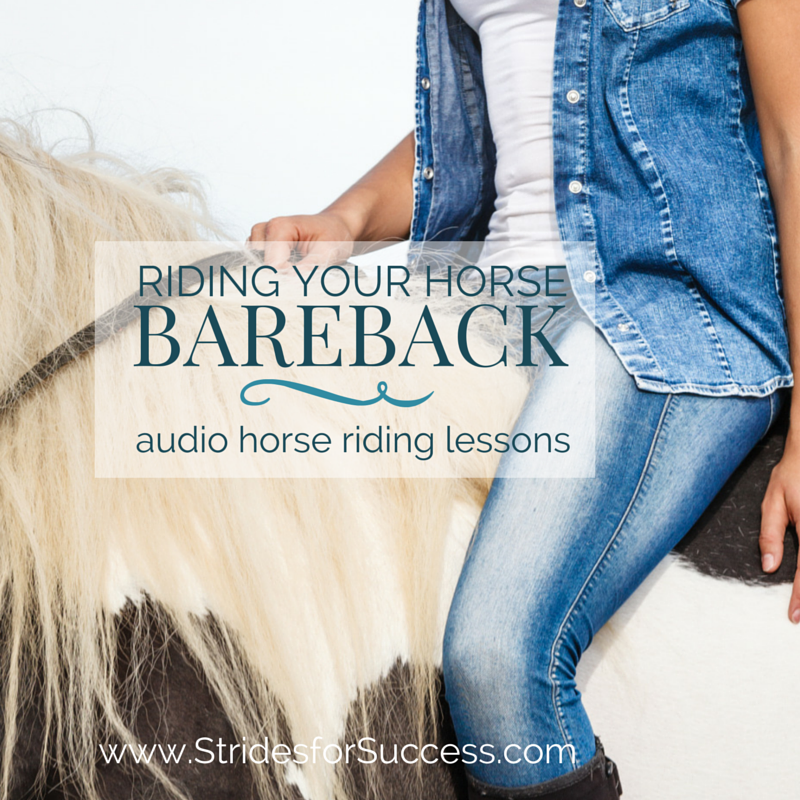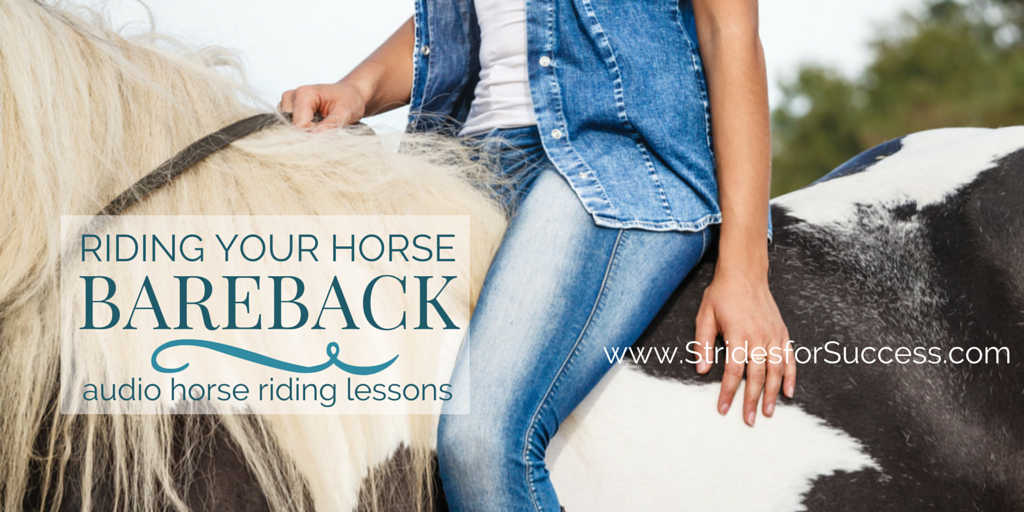Have you tried it? For many riders, the mention of riding bareback is enough to see them running to the tack room for a saddle! However, for those that pluck up the courage – it can change so much…
Bareback riding is a super way to improve your posture and position as well as balance, skills, and feel. However often the greatest challenge we must first overcome in order to achieve these benefits is our minds telling us we cannot possibly do it!
Riding bareback is not as difficult as you may think and this week I challenge you to push the boundaries of your comfort zone and try it, if only for a few minutes initially. Then gradually build your confidence and time spend ‘sans’ saddle!
Start When Cooling Off Your Horse
Perhaps a good place to start is once a week, after your lesson. Simply remove your saddle to cool down your horse. His back will be already warmed up and you are both relaxed.
Another is to ride him bareback back to the field or paddock or stable after your schooling session… little steps!
In order to get off on the right footing I strongly advice beginning with a quiet schoolmaster who has 3 really comfortable gaits and a ‘well sprung’ or comfortable back! There are fewer things more uncomfortable than riding a not so well fleshed horse bareback!
You should also try to ensure that the horse has smooth strides, not too bouncy and also not too hot or ‘goey’.
Your initial few rides without your saddle should be spent focusing on your position and posture, rather than on slowing your horse or not bouncing off.
Your Horses Comfort & Enjoyment…
Often when we initially ride bareback, we are so concerned with our own comfort and safety that we overlook our horses. Saddles are designed to disperse your weight more evenly and over a greater area of the horse’s backs.
Without the saddle, your weight will become more focused on a smaller space and may hurt or cause discomfort to your horse.
If you are new to bareback riding or feel that your balance or weight may be a negative factor for your horse, start small. Rather begin fitting in a few minutes every now and then. This will get both yourself and your horse used to bareback riding.
Once you become more balanced and better able to carry yourself, you can spend longer on your horses back.

Bareback = No Stirrups!
There are bareback pads you can get which apparently help with dispersing the pressure, however there are mixed feelings on their actual benefits, so proceed with caution.
I strongly advise not using a bareback pad with stirrups due to the lack of a properly engineered tree.
They may apply pressure where there should not be any and the possibility of hurting or damaging your horses back is quite high. Also, the whole point of riding bareback is to develop your seat and balance… So no stirrups!
A neck-strap may be used if you really feel that you need something other than the mane to hold onto if things get hairy…! Simply take one of your stirrup leathers off your saddle, remove the iron, and use the leather as a neck-strap.
1. Choose A Small Area to Ride In
Okay, so once you are good to go, find a small space such as a lunging ring or small 20 x 40 arena. Somewhere you feel safe and comfortable to start in. Also, choose a day where things are quieter around the yard and perhaps also a day where you won’t have too big of an ‘audience’ watching you!
Comfort is key to building your confidence
2. Focus on Carrying Yourself
Once mounted, make sure you are sitting up correctly, light in the saddle. Pay attention that you are not slouching. A lot of people, when riding bareback, slouch. However, this is not good for your back, or for your horses back.
Stretch up through your waist area. Then allow your legs to drape over your horse’s sides, with the weight being focused into your heel.
As you ride, think of not allowing creases across your tummy or your jersey/jacket/top. This is better than arching backwards with your shoulders. Keeping the front of your torso ‘crease free’ will help you to concentrate on carrying yourself, particularly through your waist and chest area.
Imagine a child that wants to be picked up by an adult, versus one that does not. The one that does makes themselves ‘light’, the one that doesn’t make themselves ‘heavy’. Be the ‘light’ person by making sure you are carrying yourself.
Think about being light on your horses back which will allow the horse to move underneath you. It also allows you to feel more of which individual muscles are moving and are being used for specific movements or tasks.
3. Begin In Walk
Begin in walk and allow your body to adjust. Feel the deeper, more connected seat. And allow your legs to adjust as well. You will find that your legs fall into a more natural ‘underneath’ you position without your saddle.
Try to discern what muscles, tendons and ligaments you are using to achieve this, so you can try replicate it when you do have your saddle back again.

I do realize that it all sounds so simple. However, just as when you begin riding without stirrups, you will find that while riding without a saddle can initially be daunting, it soon becomes easier and you will actually ride better when you do take your saddle back again
4. Notice Your Thoughts
The key is to gradually push the boundaries of your comfort zone. Once out there, allow yourself to get back to the safe place again. Little by little, your ‘safe’ place will move as your boundary moves. However, it takes time and never try anything that you feel you honestly cannot do. Take things slow and steady, day by day, week by week.
Once you are comfortably walking around the arena begin assessing your riding. Are you using your reins for stability?
If so, perhaps building a ‘shoot’ using poles down one of the long sides of your arena may help. You can slowly lengthen your reins as you walk down the shoot so you can concentrate on what your body is doing, rather on directing the horse with just your reins.
Often it is a mind ‘thing’ and overcoming the fears in your head is a big part of relaxing and being successful without a saddle for support
5. Remain Relaxed Through your Body
Also, don’t grip with your legs to stay on or to feel secure. It is a false security and one that will contribute to a complete lack of balance and far too much bounce when you begin to trot or canter. Also, your horse will not appreciate being in a vice grip all the while you are on his back! Your legs should remain loose, but against your horses side; cultivate your balance to stay on board.
Another important point is to ensure you are not gripping with your knees… EVER! Enough said!
Just focus on riding as you would normally do. I mentioned earlier that your leg may be slightly more underneath you and this is important to remember if you are on a more sensitive horse where you would normally perhaps ride with your leg off…
Start in a smaller space so your horse can become used to this ‘new’ and more correct leg position.
Keep your hands and arms supple and soft, don’t drop your hands and try not hold onto the mane or neck-strap as it usually causes people to round their shoulder and pivot forward a little. Only use the mane or neck-strap in case of emergency!
6. Ride Simple Transitions
Begin with simple transitions; walk – halt, halt – walk
Notice how your body can influence your horse and how you can ‘feel’ each muscle of your horse moving under you. Pay close attention to your horses reactions to both you and external influences…
Feel the sequence of movement underneath you and, after time, you will begin to be able to almost predict what your horse will do next, and respond accordingly.
Once you are comfortable travelling in straight lines, begin working on a circle, paying attention to keeping your shoulders above your hips… If you lean, this may just be the cure you have been seeking! Also, on the circle, play with your aids and notice your horses reaction in walk. Spiral the circle bigger and smaller, feeling all the time how your horse moves and how he is reacting to your subtle questions.
Are you over depending on your hands (you will feel your horses back stiffen and brace against you)? Are you forgetting to apply your outside leg? Notice the shape of the circle and your horses ability to maintain a bend and rhythm as you travel around it.
Feel how your movement interacts with that of your horse and then use this knowledge the next time you mount up with your saddle
Happy riding
Lorna
Additional Resources for Equestrians
-
-
- Learning to Stop Blocking with Your Seat – Part 1
- Learn to Stop Driving with Your Seat
- Connection in Your Riding; Seat and Legs
- Your Independent Seat is a Result of Your Independent Aids
- Your Independent Seat is Everything in Your Riding
- Improving Your Feel in the Saddle
- DEVELOP YOUR AIDS THROUGH LUNGING – UPCOMING FREE ONLINE LIVE TRAINING
- Online coaching and audio horse riding lessons for equestrians
- Groundwork for Riding
- Online community for equestrians working on their mindset & fitness
- Online Community for equestrians focusing on re-schooling horses (and ex-racehorses)
- The Daily Strides Podcast on iTunes
- The Daily Strides Podcast on Stitcher Radio
-
Have you joined us for the FREE Equestrian Fitness Challenge yet? It will definitely help strengthen your core and legs, so being unbalanced will soon become a thing of the past. Click the picture below to join in the ‘fun’ today!
Connection For Equestrians
This topic is just one of over 100 that are waiting for you inside of Connection. In this particular group of lessons, I challenge you to spend at least twelve minutes each day without your saddle. The lessons are filled with step by step instructions for you to ride simple exercises that will maximize the benefits, so you can commit to making this part of your riding schedule on a weekly or fortnightly basis.
We also put the focus on transitions, particularly of the downward variety, and how you can really understand and feel what a good transition is during your time without your saddle. This will help you when you are back in the saddle in the future. There are helpful tips, ideas, and exercises that will help you ride better downward transitions, after all, they tend to be the ones that cause us as riders to lose our balance the quickest!
Finally, the lessons will challenge you to begin adding a little trotting and, later, cantering into your bareback routine! And don’t worry, we encourage you to take your time (even over the space of a few weeks) because it will mean that when you get to perform some faster gaits without a saddle, you are confident, secure, and balanced enough to enjoy them. You can find out more about Connection HERE >>
